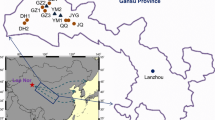Abstract
In calcareous soils from Yakutia only 0.1 % or less 239Pu and 241Am exist in water-soluble form, i.e., the mobility of these radionuclides is relatively low. In the top humus-containing layer (0–4 cm) 239Pu and 241Am are distributed uniformly between organic and inorganic soil components. In the bottom soil layer (20–30 cm) the radionuclides are present mainly in inorganic soil components. The estimation of the radionuclide mobility demonstrates that 241Am is potentially a more mobile element than 239Pu. In the considered calcareous soils collected from the top layer 239Pu and 241Am exist both in humic and fulvic acids (FA). 241Am is much stronger bound to the group of mobile FA than 239Pu. In the bottom soil layer 239Pu and 241Am have been found mainly in FA.




Similar content being viewed by others
References
Erofeevskaya LA, Aleksandrov AR (2012) The influence of radio nuclides on the soil microbial community on the territory of the underground nuclear explosion 'Kraton- 3' (Yakutia). Arct North 8:1–11
Sobakin PI, Gerasimov YR, Chevychelov AP, Perk AA, Goryachenkova TA, Novikov AP (2014) Radioecological situation in the zone affected by accidental nuclear explosion Kraton-3 in Sakha (Yakutia) republic. Radiatsionnaya biologiya. Radioekologiya 54:1–9
Chevychelov AP, Sobakin PI, Molchanova IV (2006) Radioactive contamination of permafrost-affected soils with 137Cs and 90Sr, the products of an accidental underground nuclear explosion. Eurasian Soil Sci 39:1362–1369
Goryachenkova TA, Pavlotskaya FI, Myasoedov BF (1991) Forms of occurrence of plutonium in soils. J Radioanal Nucl Chem 147:153–157
Miller WP, Martens DC, Zelazny LW (1986) Effect of sequence in extraction of trace metals from soils. Soil Sci Soc Am J 50:598–601
Clark SB, Johnson WH, Malek MA, Serkiz SM, Hinton TG (1996) A comparison of se-quential extraction techniques to estimate geochemical controls on themobility of fission product, actinide, and heavy metal contaminants insoils. Radiochim Acta 74:173–179
Goryachenkova TA, Kazinskaya IE, Clark SB, Novikov AP, Myasoedov BF (2005) Comparison of methods for assessing plutonium speciation in environmental objects. Radiochemistry 47:599–604
Fedotov PS, Spivakov BY (2008) Fractionation of elements in soils, sludges and sediments: batch and dynamic methods. Russ Chem Rev 77:649–660
Novikov AP (2010) Migration of radionuclides in the environment. Geochem Int 48:1285–1398
Orlov DS (1992) Khimiya pochv [Chemistry of soils]. Moscow State University, Moscow
Forsyth W (1947) Studies on the more soluble complexes of soil organic matter. Biochem J 41:176
Varshal GM, Velyukhanova TK, Sirotkina IS, Yartseva RD (1973) Separation of fulvic acid by activated carbon. Fractionation, quantitative definition and study of certain major components of dissolved organic substances in natural waters. Gidrokhim Mat 59:143–151
Kazinskaya IE, Goryachenkova TA, Novikov AP, Vinokurov SE, Trkachev VV (2012) Association of radionuclides with components of fulvic acids isolated from soils. Radiochemistry 54:87–91
Pavlotskaya FI (1997) Main principles of radiochemical analysis of environment objects and methods for the determination of radionuclides of strontium and transuranium elements. Zh Anal Khim 52:126–143
Vorob’eva LA (1998) Khimicheskii analiz pochv [Chemical analysis of soils]. Moscow State University, Moscow
Dubasov YuV, Krivokhvatskii AS, Savonenkov VG, Smirnova EA (1991) Types pf fuel particles in the sediments of the near zone of Chernobyl nuclear station. Radiokhimiya 33:102–103
Tamm O (1934) Uber der oxalatmethode in der chemischen Boden analyse. Meda Fr Stat Shogsfürst 32:3–11
Acknowledgments
The research was financially supported by Russian Foundation for Basic research (Project No. 14-05-00181) and Ministry of Education and Science (Federal Targeted Program for Research and Development in Priority Areas of Development of the Russian Scientific and Technological Complex for 2014-2020 (Agreement No. 14.604.21.0095 UIS RFMEFI60414X0095).
Author information
Authors and Affiliations
Corresponding author
Rights and permissions
About this article
Cite this article
Novikov, A.P., Goryachenkova, T.A., Sobakin, P.I. et al. Speciation of plutonium and americium in the soils affected by Kraton-3 accidental underground nuclear explosion in Yakutia (Russia). J Radioanal Nucl Chem 307, 691–697 (2016). https://doi.org/10.1007/s10967-015-4195-1
Received:
Published:
Issue Date:
DOI: https://doi.org/10.1007/s10967-015-4195-1




